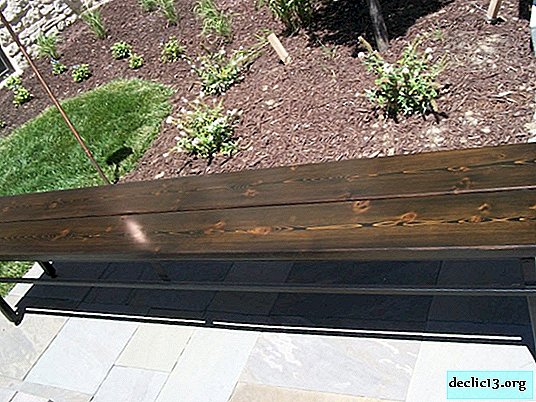Simple ways to paint furniture facades, important nuances of technology
Sometimes, every person wants changes in his environment, for example, to completely remake the interior in a room or in the kitchen. Painting of furniture facades will help to fit old cabinets into a new environment. This measure helps to significantly save on replacing furniture sets and choose the color of new rooms, not limited to shades of existing things. The owners will be able to do all the work on their own, even if they had not previously had to paint furniture.
Necessary tools and materials
If the decision to change the interior is final, painting of furniture facades becomes inevitable. Before starting work, you should determine the necessary tools materials:
- Paint (oil, latex, water dispersible, alkyd, stain). Auto enamel can be used, it is moisture resistant, does not change its appearance with temperature changes;
- Paint rollers and brushes. They are selected depending on the paint used: for water-based emulsion choose velor, and for acrylic, stain or varnish - brush, roller made of natural or combined wool;
- The primer must be purchased depending on the chosen paint. The suitability of the materials can be determined after a careful study of the packaging;
- Degreaser. For facades made of wood or MDF, a composition comprising an organic solvent is used. This product is capable of removing grease, oils, fats, silicones;
- Sandpaper, felt, a piece of wool;
- Building hair dryer;
- Gloves;
- Masking tape;
- Screwdriver or screwdriver;
- Drill.
Any furniture facades can be painted, but products from MDF and solid wood behave better than the others in this procedure.

Paint technology
The durability of the coating depends on the correct application of the paint. First of all, it is necessary to prepare the space for work. Furniture facades should be painted in a large, well-ventilated room. The air temperature is maintained at least 20 degrees Celsius.
Surface preparation
When the room for painting is selected and there are all the necessary tools, you can proceed to the first stage. First, you need to disassemble the furniture and remove all the accessories from the facades. The old coat of paint is removed from the stove. At this stage, it is convenient to use a building hair dryer, it allows you to perform this work in less time. The pre-heated paint begins to peel off and is easy to remove.
You can use special solvents to remove paint, but such compositions have an unpleasant corrosive odor, which makes it impossible to use indoors. Another alternative to building hair dryers is coarse sandpaper. Manual paint removal takes a lot of time. When using sandpaper, a large amount of dust appears, it will be necessary to periodically remove it with a vacuum cleaner. There is a possibility of damage to the facade itself, so sandpaper is best used in extreme cases.
It is not always necessary to completely remove the old coat layer. Applying paint to a varnished surface is inefficient due to poor adhesion. Sanding the part will help to increase it. After processing, you can proceed to degreasing and painting. It is worth remembering that MDF panels are very often covered with a polyvinyl chloride film, it must be completely removed and only then proceed to the next stages of work. The surface under the film is treated with sandpaper.
Under the coating layer surface defects are visible. To deal with cracks, chips and dents, you can use putty for wood.
- Gypsum putty is an environmentally friendly option with a low cost and good performance properties, great for indoor work, as it does not have a pungent odor;
- Latex or acrylic formulations have greater durability, but their cost is much higher. The composition is applied in a thin layer (1-2 mm) to avoid cracking after solidification.
Putty of the base layer may not be combined in color with the workpiece, but it should not stand out on the surface. The base coat should have good adhesion for better adhesion to the paint.
 Remove a layer of old paint
Remove a layer of old paint Degreasing coating
Degreasing coating Putty on cracks
Putty on cracksGrinding
To obtain a smooth surface after painting, you must first think about grinding it. After applying and completely drying the putty, you need to arm yourself with large emery paper and clean the surface. The grain size of the abrasive material used is gradually reduced to bring the surface to a perfectly smooth state. Do not get involved in the process and use the smallest types, it is quite enough to process wood boards with paper marked P400 and P600.

Painting
Painting includes several stages:
- Degreasing - first, the sanded surface is treated with a degreaser. To do this, the panels are wiped with a swab moistened with the composition. After work, the surface should dry. It is not allowed to touch fat-free wood. This step is necessary for a good adhesion of the wood panel and the applied paint. The degreaser dries very quickly, so a few minutes after applying it, you can proceed to the next step;
- Primer - this should be a special composition for use on wooden surfaces. For uniform application of the primer, each subsequent layer should be perpendicular to the previous one. Do-it-yourself priming of facades with a roller or brush. The primed part must dry, it will take about a day;
- The next step is painting. The technology for its implementation may differ, depending on the materials, the initial and desired color of the furniture facades. In any case, the painting should be started from the ends of the workpiece and only then proceed with the processing of the front side.
Before applying the paint with a spray gun, you can practice on a workpiece or an unnecessary piece of wood. This will help you choose the optimal spray width; it should be small. Depending on the color of the workpiece and the paint, it is necessary to apply several layers, usually three is enough, but if the parts painted with color have unevenly worked out parts, then it may be necessary to coat several more times.
After each layer, part of the facade is left for 10-15 minutes and the paint is allowed to dry a little. You can paint light parts using tint varnish, when applying several layers of which the part acquires the necessary shade. It should be remembered that light paint applied to dark wood completely covers the structure of the material.
 Degreasing coating
Degreasing coating Primer
Primer Paint the surface
Paint the surfaceApplying varnish
Correctly painting the facade is not enough, it is necessary to protect the new coating from accidental damage, exposure to direct sunlight, moisture. To do this, it is advised to apply a layer of varnish.
- First you need to determine the type of varnish. Nitrolac is excellent for outdoor use, protects wood from environmental influences, it is very toxic and is not intended for indoor use. Water-based varnish is an environmentally friendly composition used indoors. It will take about two weeks to fully dry;
- Next, you can begin to prepare the premises. Varnishes dry for a long time and during this time there should be a minimum amount of dust around the furniture element. To do this, before starting work, wet cleaning should be carried out, a protective film should be laid on the floor against accidental contact with varnish. The air temperature during operation should be +20 degrees. Even when using odorless materials, care must be taken to ensure good ventilation;
- Before applying varnish, the surface must be cleaned of dirt and treated with fine-grained sandpaper. Movements should be directed along the wood fibers. You can clean the product from dust with a vacuum cleaner. Do not use a damp cloth;
- The surface is again covered with a primer and wait for its complete drying;
- Application of varnish. The choice of tool depends on the material. The brush is used when working with oil varnishes. For uniform application, it is advised to choose tools with natural bristles, split at the ends. The swab is needed for alcohol-based varnish. It can be made from a small piece of wool wrapped in linen cloth. The tool is completely dipped in a varnish and impregnated with it, then applied with quick movements along the fibers. Sprayer to speed up the application process. Use it is allowed only in rooms with excellent ventilation.
 Choosing furniture varnish
Choosing furniture varnish We carry out wet cleaning
We carry out wet cleaning We process facades with sandpaper
We process facades with sandpaper Ground surface
Ground surface Varnish
VarnishFinishing and decoration
After the varnish has dried, it is necessary to polish the surface. First, coarse defects are removed with fine sandpaper, and only after that they start polishing with special compounds and tampons from flax. To obtain a good result, the polishing mixture is applied with quick movements in three layers with an interval of 12 hours.
After finishing work, you can assemble furniture. The holes for fixing hardware, most likely, will have to be drilled again, because the old ones will be primed, covered with paint and varnish. All parts must be reinstalled.
 We remove gross defects with sandpaper
We remove gross defects with sandpaper Polish the surface
Polish the surfaceCommon mistakes
Painting is a complex and time-consuming process, so during operation often unpleasant errors occur, leading to marriage and defects:
- The absence of varnish on the surface, as a result of which the paint is soon worn away, scratched and spoiled
- Touching a fat-free surface, or completely neglecting this step. The paint will peel off and go unevenly;
- Extraneous debris on a dry surface of paint or varnish;
- Painting parts without first removing the old layer;
- Low humidity, during work it should be at least 70%;
- Application of very thick materials, resulting in the formation of "shagreen leather". This defect cannot be fixed, so you should pre-test the material on a test sample;
- Lack of personal protective equipment. Paint and varnish are washed off very hard and can cause irritation on the skin;
- Poor ventilation can lead to poisoning by harmful fumes;
- Not enough paint. Mixing it with color is necessary to lay a small margin;
- Violation of storage standards for materials, as a result of which they become unusable.

















